WORLD CLASS COACHING
40 Individual Defending and Small Group Exercises
By Luca Bertolini
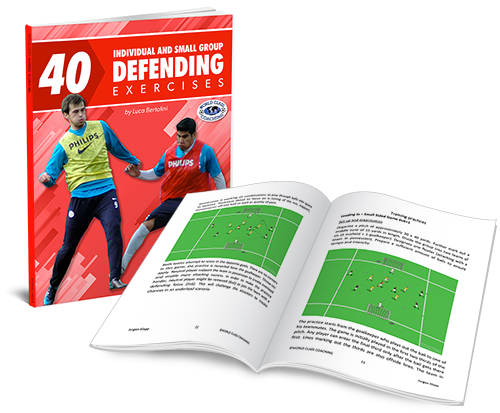
Table of Contents
PART FOUR
3v3 Exercises
4v4 Exercises
3 v 3 Exercises
Exercise 33 - 3 v 3: prevent the opponents from playing behind the defense line (1)
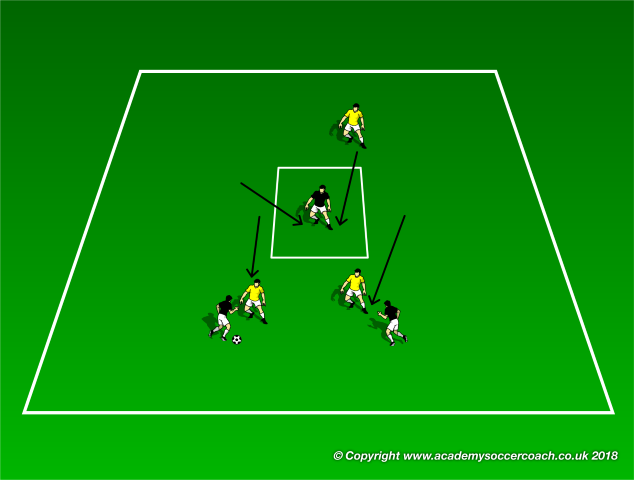
Set-up and Sequence: a 3 v 3 possession duel is played inside a rectangular space; the goal for the possession team is to make a player receiving a pass inside the center smaller area. This is a directed possession game; the black players must play from the bottom to the top, when in possession, and the yellows vice versa.
The defenders must be able to move over the middle area and to put pressure to avoid the players in possession from passing at their back and toward the center area, where the third defender can run inside to counter the opponent, who is dropping back there; if the player in possession is able to send a back pass, then the attacking team gains 1 point.
If the defenders recover the possession, they must keep the ball, trying to find the way to direct the possession to win the point. The players who lost the possession must counter press immediately, as transition to defend, to avoid the positioning of the new team with possession.
Eye on: pressure to close the passing lanes, to prevent an opponent from receiving and to counter the transitions to attack phase of play. Anticipation and tackling against the center player while moving or receiving.
Exercise 34 - 3 v 3: prevent the opponents from playing behind the defense line (2)
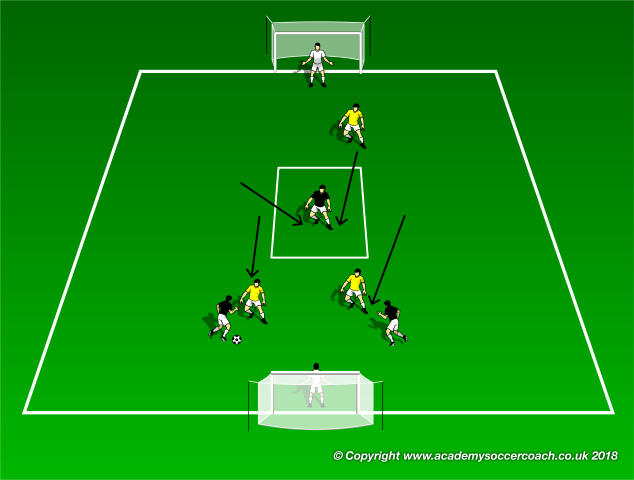
Set-up and Sequence: this is a variation of the previous exercise. A 3 v 3 possession duel is again played inside a rectangular space, but 2 goals with goalkeepers to defend and to attack are placed along the shorter sides of the rectangle. The black players must play from the bottom to the top, when in possession, and the yellows vice versa.
The defenders must be able to move over the middle area and to put pressure to avoid the players in possession from passing at their back and toward the center area, where the third defender can run inside to counter the opponent, who is dropping back there. If the player in possession is able to send a back pass, then the team is free to attack the opposition goal to score.
If the possession team is able to attack the opposition goal, than the defenders must retreat quickly to save the goal space. If the defenders recover the possession, they must keep the ball, trying to counter attack freely. The players who lost the possession must counter press immediately, as transition to defend, to avoid any counter attack or possession phase.
Eye on: pressure to close the passing lanes, to prevent an opponent from receiving and to counter the transitions to attack phase of play. Anticipation and tackling against the center player while moving or receiving.
Exercise 35 - 3 v 3: shape defense triangles
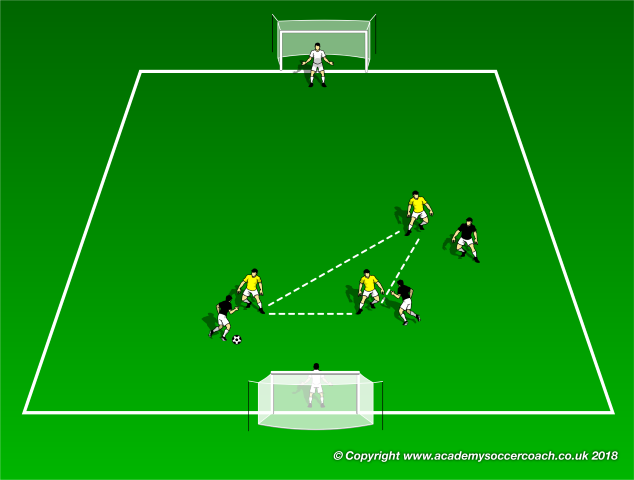
Set-up and Sequence: a 3 v 3 possession duel is again played inside a rectangular space and 2 goals with goalkeepers to defend and to attack are placed along the shorter sides of the rectangle. The black players must play from the bottom to the top, when in possession and the yellows vice versa. The defenders must be able to shape defensive triangles; 2 of them must press the ball carrier and the nearest opponent, who is placed along the easiest passing lane. The third defender must decide if to close the goal space, providing balance, or to mark the last opponent on, if he's close to the goal to defend or if he's placed in a useful position to finish.
If the possession team is able to attack the opposition goal, than the defenders must retreat quickly to save the goal space. If the defenders recover the possession, they must counter attack freely and as quickly as possible. The players who lost the possession must counter press immediately, as transition to defend, to avoid any counter attack or possession phase.
Variation: the coach can play a second ball to manipulate transitions to attack and to defend, to force the player shaping defensive triangles.
Eye on: pressure to close the passing lanes, provide balance at the back, mark the opponent on if he is placed in dangerous positions, counter pressing to avoid counter attacks, quick transitions.
Exercise 36 - 3 v 3: pressure and balance
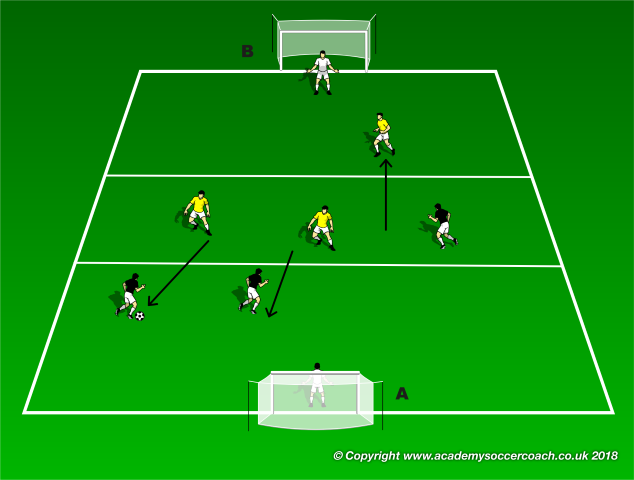
Set-up and Sequence: a 3 v 3 possession duel is played inside a rectangular space and 2 named goals with goalkeepers to defend and to attack are placed along the shorter sides of the rectangle. The playing area is divided into 3 parts; all the players start each sequence from the middle one.
The coach indicates which is the goal to attack (B in the picture) and this way he finds out the attacking team (black) and the defending team (yellow). 2 players of the black team must drop back inside the first third to build up and 2 of the defending must put pressure in final third; the third defender must drop back inside the first third to cover the goal space and to counter the potential inside runs of the third attacker.
Variation: the coach can play a second ball to manipulate transitions to attack and to defend, to force the player shaping defensive triangles.
Eye on: pressure to close the passing lanes, provide balance at the back, mark the opponent on if he is placed in dangerous positions, counter pressing to avoid counter attacks, quick transitions.
Exercise 37 - Alternate 4 v 3: numerical advantage and disadvantage
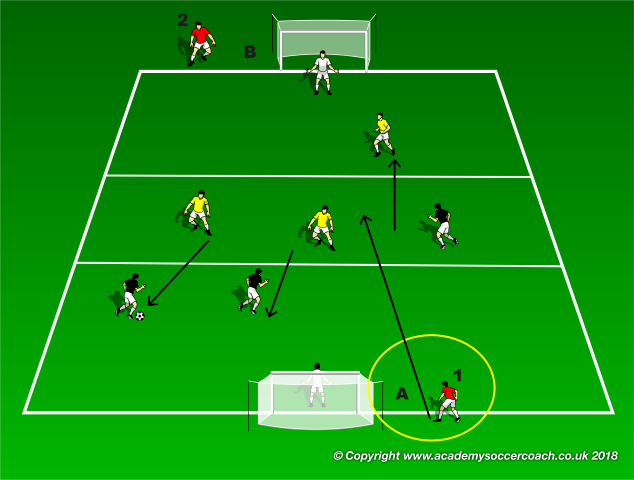
Set-up and Sequence: a 3 v 3 basic possession duel is played inside a rectangular space and 2 named goals with goalkeepers to defend and to attack are placed along the shorter sides of the rectangle. The playing area is divided into 3 parts; all the players start each sequence from the middle one.
The coach indicates which is the goal to attack (B in the picture) and this way he finds out the attacking team (black) and the defending team (yellow). 2 players of the black team must drop back inside the first third to build up and 2 of the defending must put pressure in final third; the third defender must drop back inside the first third to cover the goal space and to counter the potential inside runs of the third attacker.
A fourth defender, the free player 1 in the picture, runs inside the middle third of the pitch to create defense numerical advantage 3 v 2; but he can't run out of this part. If the forward are able to play out of the middle third, he can't defend again. The pressure against the opposition building up has to be strong then.
Variation: if the forwards are able to play in the middle third, the other free player can run inside to create numerical advantage for the possession team. The defenders are then outnumbered 3 v 4 in the first third; they have to save the goal space, rather than to press the opponents.
Eye on: pressure to close the passing lanes, provide balance at the back, mark the opponent on if he is placed in dangerous positions, counter pressing to avoid counter attacks, quick transitions.
4 v 4 exercises
Exercise 38 - 4 v 4: double 2 v 2, alternate pressure and balance
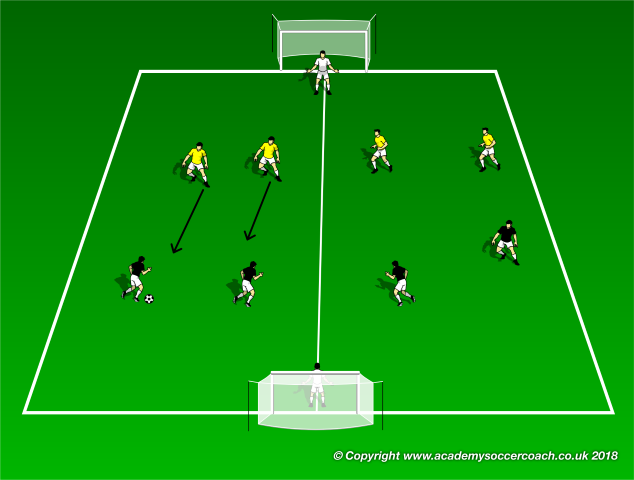
Set-up and Sequence: a 4 v 4 possession duel is played inside a rectangular space and 2 goals with goalkeepers to defend and to attack are placed along the shorter sides of the rectangle. The playing area is divided into 2 parts vertically; 2 v 2 duels are played inside each area.
The coach decides which is the attacking team and the defending team by passing the ball. The 2 defenders of each part, where the ball is being played, must put pressure to prevent the possession team from switching play to other side. The attacking team can finish after a fix number of switches of side. The other 2 defenders must save the goal and be ready to press the first receiver and the other opponent. If the defenders win the ball, they can counter attack freely and a 4 v 4 duel is played.
Variation: the coach can play a second ball to manipulate transitions to attack and to defend.
Eye on: pressure to close passing lanes, provide balance at the back, save the space, mark the opponent on if he is placed in dangerous positions, counter pressing to avoid counter attacks, quick transitions.
Exercise 39 - 4 v 4: double 2 v 2, create a strong defense side and cover the weak one.
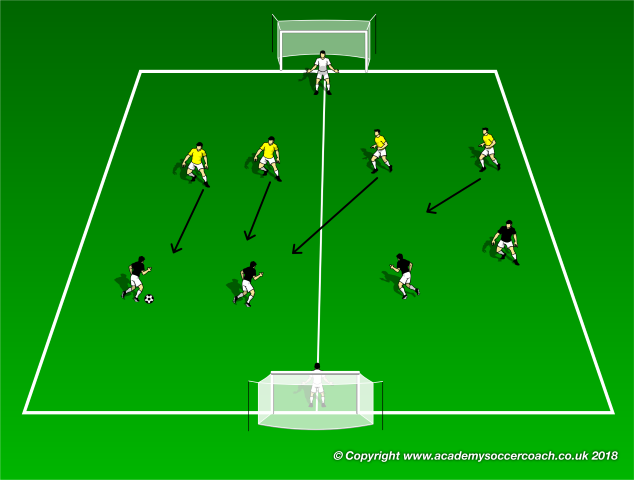
Set-up and Sequence: this practice is a variation of the previous one. A 4 v 4 possession duel is played inside a rectangular space and 2 goals with goalkeepers to defend and to attack are placed along the shorter sides of the rectangle. The playing area is divided into 2 parts vertically; 2 v 2 duels are played inside each area. The coach decides which is the attacking team and the defending team by passing the ball. When a couple of the attacking team has the possession, the defenders inside the same half must be supported by a third teammate coming from the opposite side, to create numerical advantage 3 v 2 and a strong side. The defender on the other half is outnumbered 1 v 2. The goal of the defenders is to recover the possession as quickly as possible to counter attack, avoiding any switch of side by the forwards.
If the forwards are able to switch the side, the defender must try to slow down the rhythm of play, waiting for the support of a teammate (2 v 2) or for a new numerical advantage situation 3 v 2. If the defenders win the ball, they can counter attack freely and a 4 v 4 duel is played; the team that lost the possession must act immediately to organize a counter-pressing move.
Variation: the coach can play a second ball to manipulate transitions to attack and to defend.
Eye on: pressure to close passing lanes, provide balance at the back, save the space, exploit the strong side and cover the weak one, counter pressing to avoid counter attacks, quick transitions.
Exercise 40 - 4 v 4: double 2 v 2, cover and balance.
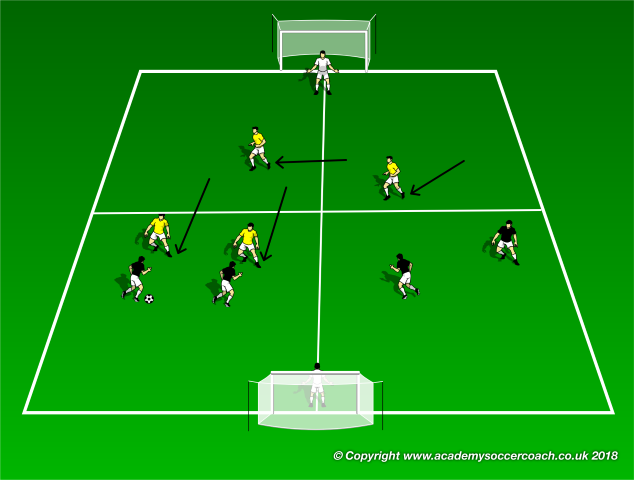
Set-up and Sequence: 4 v 4 possession duel is played inside a rectangular space and 2 goals with goalkeepers to defend and to attack are placed along the shorter sides of the rectangle. The playing area is divided into 4 parts vertically and horizontally; 2 v 2 duels are played inside half and 2 players are placed inside a quarter of the pitch, as in the picture.
The coach decides which is the attacking team and the defending team by passing the ball. When a couple of the attacking team has the possession inside a quarter of the field, the defenders of the same half and of the quarter in front, run inside the opposition part to put pressure 2 v 2. 1 defender from the opposite side must provide cover behind them and inside the free quarter of the pitch. The fourth defender must be placed near the playing half. This way a safe strong side is created, but a weaker side is left in the other part.
The goal of the defenders is to recover the possession as quickly as possible to counter attack, preventing any switch of side by the forwards and staying balanced at the back.
If the forwards are able to switch the side, the first defender there must try to slow down the rhythm of play, waiting for the support of a teammate (2 v 2) or until the same defense situation is created again. If the defenders win the ball, they can counter attack freely and a 4 v 4 duel is played; the team that lost the possession must act immediately to organize a counter-pressing move.
Variation:
1. The coach can play a second ball to manipulate transitions to attack and to defend.
2. If the possession team loses the ball, the same defense pattern must be created as soon as possible.
Eye on: pressure to close passing lanes, provide cover and balance at the back, save the space, exploit the strong side and cover the weak one, counter pressing to avoid counter attacks, quick transitions.


